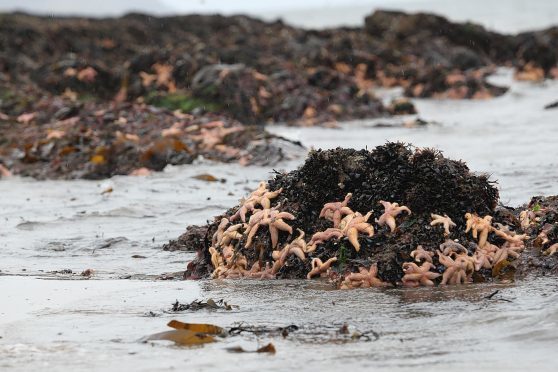It looks like a scene from an alien invasion film.
But this starfish stranding was spotted on a Black Isle beach yesterday.
Thousands of starfish have landed at Rosemarkie, covering a 100-yard area, possibly in a phenomenon known as “starballing”.
Rosemarkie Beach Cafe wrote on Facebook:”Some areas of the shore between the Café and Cairds Cave are covered in stranded starfish. “This is a natural event, usually a combination of a strong onshore wind and a choppy sea. Some will make it back out to sea as the tide rises.
“Starfish live on mussels on the seabed in fairly shallow waters and if the conditions are wrong there will sometimes be a mass stranding like this. These starfish are becoming part of the food chain, pleasing our coastal seabirds no end.”
Another local, who did not want to be named, said:”I have never seen this before. It really was quite a shock – nobody really knows what has happened.”
But last year scientists said they believe they may have discovered the reason why common starfish are prone to mass beach strandings during strong wind and tide conditions.
Researchers at Plymouth University observed the species Asterias rubens rolling along the seabed with arms curled into a spheroid shape – a phenomenon they’ve termed “starballing”.
It is not yet known whether the technique is a deliberate one that helps the otherwise slow-moving species to change their location, but some were recorded raising a single arm into the water column prior to moving as if to test the conditions.
Dr Emma Sheehan, a Research Fellow in Plymouth’s Marine Institute, said: “The common starfish is naturally a slow-mover, travelling at no more than 67 centimetres per minute, with its thousands of tube feet navigating the terrain as it looks for food. Its larvae have therefore long been considered as the reason the species is so widespread throughout the North Atlantic. “But this newly-observed phenomenon of ‘starballing’ might both shed further light on their distribution and explain how mass strandings occur.”
Analysing the pictures later, the scientists found that as the tidal flow increased to 0.5 metres per second, the starfish were rolling over the seabed with the arms curled into a ball. Around 30 per cent of the starfish in the area were observed to be rolling, and some were seen to raise a single arm into the water column as if to test the speed of the flow.
“At this point, we simply cannot say whether the starballing individuals were swept off the seabed by the strong tidal flow, or if the individuals allowed themselves to be transported.”
